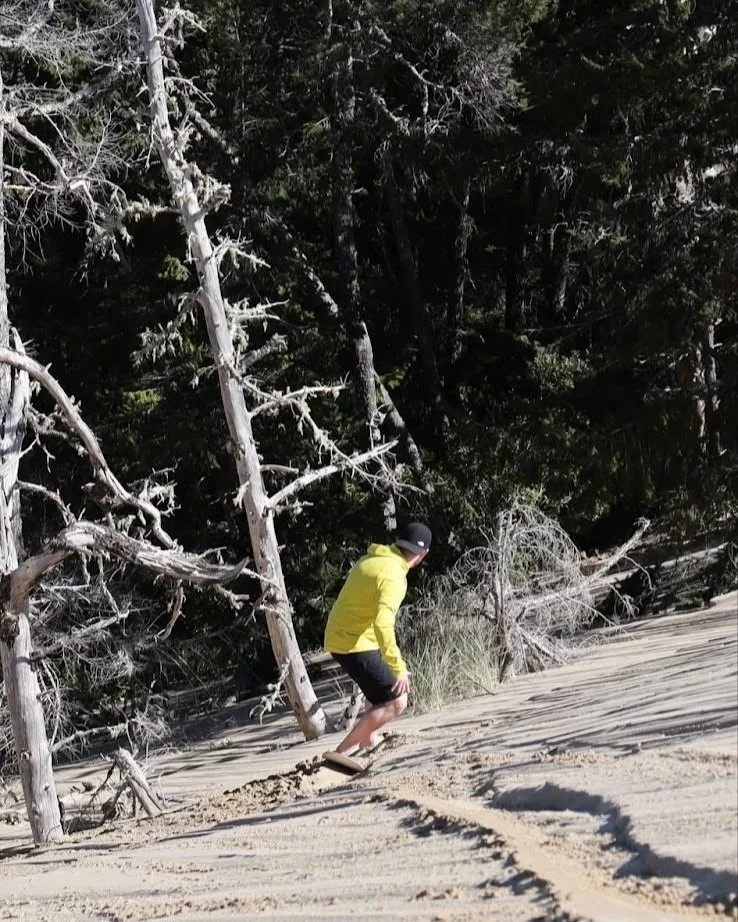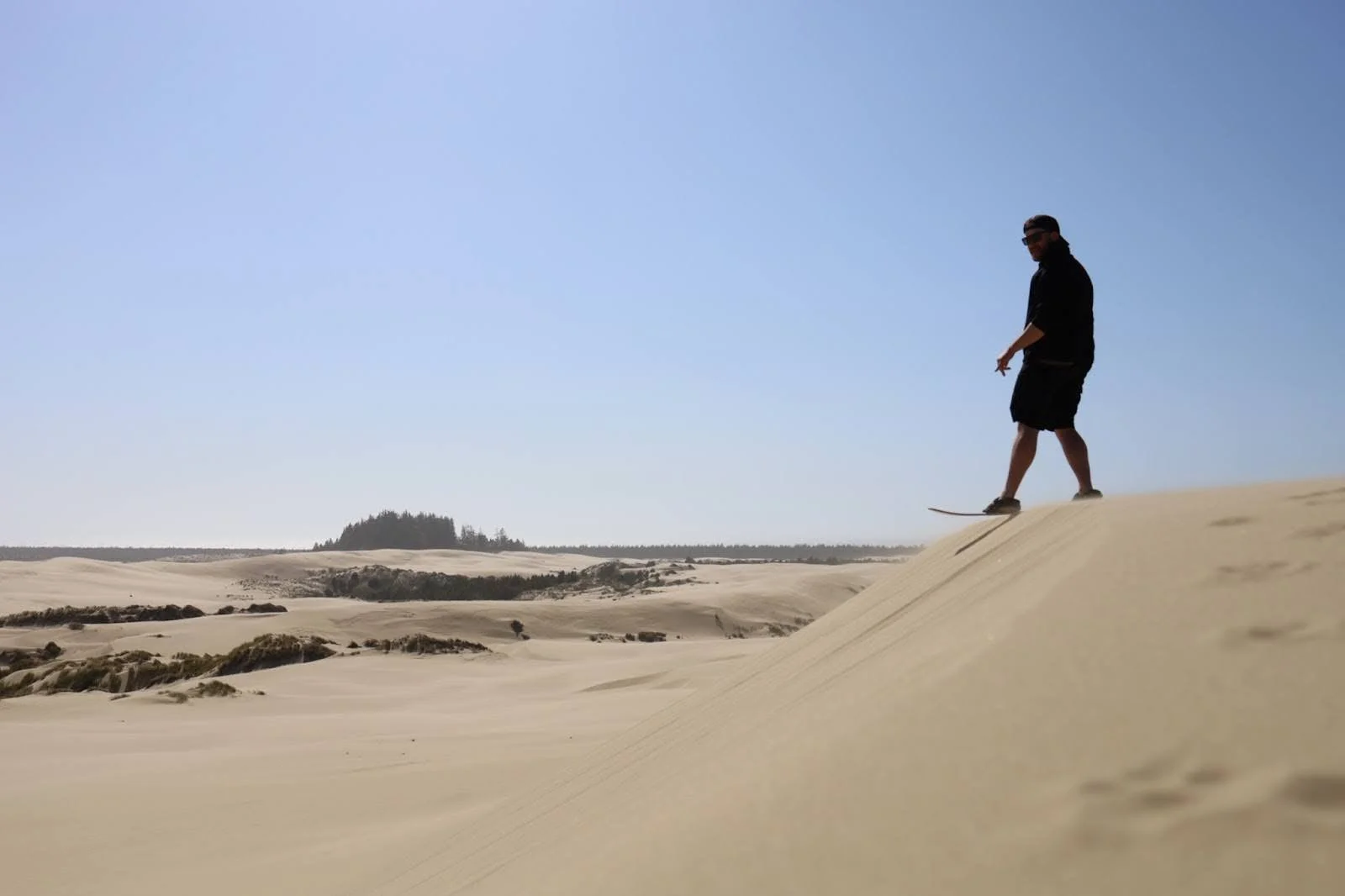Coastbound: A Backcountry Sandboarding Guide to the Oregon Dunes
A Quick Guide to Sandboarding the Oregon Dunes
Location: Oregon Dunes National Recreation Area (Florence to Coos Bay)
Best Season: May to September (dry sand only)
Skill Level: Beginner to Expert
Terrain: 40 miles of dunes, beaches, forests, and lakes
Must-Visit Spots: John Dellenback Dunes Trail, Honeyman State Park, Sand Master Park
What to Bring: Board, wax, sunscreen, sun hoodie, goggles/sunglasses, lip balm, water, snack, footwear, optional 4x4 gear if offroading or overlanding
Visitor Info: Stop by the ODNRA Visitor Center in Reedsport for maps, permits, and local guidance.
Where the Dunes Came From
The Oregon Dunes were shaped over millennia by coastal winds, river sediment, and shifting tides. Some dunes rise over 500 feet above sea level, forming an alien-like landscape of ridges, bowls, and razorback runs. This wild topography here even inspired Frank Herbert’s Dune saga after he visited in the 1950s.
Long before sandboarding became popular, the Siuslaw and Coos peoples lived along this coastline, adapting to the dunes as part of their seasonal life-ways. Today, the Oregon Dunes continue to hold both cultural importance and recreational value, protected as part of the Siuslaw National Forest.
What Exactly Is Sandboarding?
Sandboarding is like snowboarding’s barefoot cousin born under the sun, raised by the wind, and fueled by gravity. You’ve probably seen someone try to sled or tumble down a sandy hill before, maybe even attempted it yourself. But true sandboarding is something else entirely.
Picture a blend of snowboarding and surfing, only you’re carving lines down sun-scorched dunes instead of frozen peaks or ocean waves. Sound wild? It is. And Oregon’s dunes offer some of the best sand in the U.S., if not the world. Even so, many people visiting the coast have no idea sandboarding exists, let alone that it’s thriving here, with 40 miles of surreal terrain ready to be explored. And the best part? The backcountry zones are wild, wide open, and completely free. difference.
Getting Started (and Why It’s Trickier Than You Think)
Sandboarding may seem simple: grab a board, find a hill, and shred. But there are some critical factors that separate a good run from a disappointing slide.
First: steepness matters. A dune must be pitched enough for gravity to do its job. If it’s too flat, you’re going nowhere. And, unlike snow, sand creates friction. This means that wax is essential for a smooth ride. Most boards need to be waxed before every run. And remember, like Mr. Miyagi taught us: wax on, wax off. Just as you need to add wax, it must also be buffed out before each run. This is done by putting your hands inside the bindings and swiping the board’s base side to side into the sand over and over until excess wax is removed and any remaining wax is polished in.
If you give your board a little toss forward onto the sand and it glides freely on its own, you’re good to go. If not, add more wax or buff again. Lastly, sandboard on dry sand only. Moisture kills momentum. Sandboarding works best under sunny skies with a dry breeze. Wet sand is simply a no-go unless you’re experimenting with specialty gear… which, for now, mostly exists in rumors.
Pro Tips for Beginners
Want to try sand boarding but aren’t sure where to begin? Here are a few tips you can use to help make the most of your days on the sand:
Stance is key: Bend your knees, lean slightly into your rear foot, and keep your eyes looking downhill. Look away, and the sand will introduce itself to your face.
Falling isn’t bad: The soft sand makes spills part of the fun and much less painful than snow or concrete.
No lifts, No problem: Like backcountry snowboarding, sandboarding is all hike-and-ride. Bring a hydration pack, snacks, and gear that can take a beating. You can even use trekking poles with powder baskets to aid in the cross-country trek and dune ascents.
Goggles are your best friend: Dune winds can whip sand into your eyes like a micro sandblaster. ATV goggles or wraparound glasses are a must.
Lip balm and sunscreen: Underrated essentials. The dunes are beautiful, but brutal.
Footwear: Sometimes sand can be scorching hot, so wearing something on your feet while hiking the dunes is beneficial. However, most sandboarding is best done barefoot, so having something easy to slip on and off is key. (Sand socks even exist!)
Boards, Bindings & Beeswax
Sandboards resemble snowboards, but that’s where the similarities end. Most range from 100 to 150 centimeters, with shorter boards favored by beginners or kids, and longer ones for experienced riders. Styles include directional freeride boards, Best for general use and stability; freestyle twin-tip boards, great for tricks and switch riding; and race boards, built for speed and control.
Bindings are typically footstraps, often lined with neoprene or EVA pads. Some advanced riders use snowboarding gear, but sand will tear it up fast. And waxing? Wax is your best friend. Apply it before every run, buff it properly, and test glide before dropping in. There may be other wax formulations locally available at Sand Master Park, so it’s worth checking in with the shop to see what works best in current conditions.
Backcountry Access & Dune Camping
For the more adventurous riders, the dunes open up like a vast wilderness. We often drive our Jeep Wrangler out to access untouched runs and camp in wind-shielded tree pockets. Dispersed camping here is unlike anywhere else.
Some of the magic is not knowing exactly where you’re going. Venture out with no real destination and discover. Dune time flows differently, and the best campsites are often the ones you stumble upon. But preparation is key. ATV Permits, Safety Flags, and a Fire Extinguisher are required for all 4x4 vehicles. Vehicle recovery gear is also recommended! And of course, be sure to bring extra food, water, and clothing in case of unexpected delays or overnight stays
Top Sandboarding Spots on the Central Oregon Coast
John Dellenback Dunes Trail (North Bend): Pristine, foot-traffic only. A personal favorite for its clean lines and silence.
Jessie M. Honeyman Memorial State Park (Florence): Great for beginners, families, and scenic runs that lead right to the water’s edge.
Drake Dune, Banshee Hill, Bushy Hill (Winchester Bay): The tallest dunes in the entire region. Be mindful of ATVs!
Also, Look for spots without footprints. Some of the best runs are hidden, natural chutes on the edge of forests or forgotten ridgelines waiting to be discovered.
Q: What does it feel like right before you drop in on a dune?
A: It feels OMG. Great. Like my heart’s beating with the wind!
Q: What’s it like when you’re actually riding down?
A: It’s really exhilarating—especially going into a bowl or just a flat sand dune.
Q: Do you ever get scared up there?
A: Yes, I do.
Q: What do you do when you feel scared?
A: I take a deep breath and try to calm down. I’ve learned to believe in myself.
Q: What’s your favorite thing about sandboarding?
A: My favorite thing about sandboarding is that sometimes you can do it alone, but I like doing it with my family.
Q: Do you remember your best run ever?
A: Yeah! It was at Cape Kiwanda—at the top with my friends, my dad, the view, the drop—and all of us riding together.
Q: What do you see when you’re at the top of a big dune?
A: The whole world. “The landscape, the people, and mostly nature—being how it is on its own.”
Q: What do you hear out there?
A: The wind whistles. Birds chirp. Sometimes it rains. And sometimes I hear other people shouting with joy.
Q: What does the sand feel like?
A: Different every time. Hot or dry or soft, depending on where you are.
Q: What’s the perfect weather for sandboarding?
A: A little sunny, I think, but it should still get cool later, so the sand stays nice and smooth.
Q: Do you like it when it’s windy?
A: Sometimes. Because if someone’s taking a picture of me, I look cool.
Q: What do you imagine when you’re riding?
A: I see my happy place. All my family. It’s like they’re with me in my head—cheering me on—even if it’s just me and the dune.
Q: Do you think other kids should try sandboarding?
A: Yes! Because you can just sort of be yourself in your own way.
Q: Who do you like riding with the most?
A: My dad because he motivates me. He always keeps me going.
Q: What would you say to the next generation of sandboarders?
A: Don’t be afraid to hide your true colors.
Q: If you could ride anywhere in the world, where would you go?
A: I’d find the biggest sand dune in the world—and go there.
Final Tracks
Some of my best memories were made in the dunes…hiking barefoot up warm, sloping ridges with my daughter, the sun dipping low behind the horizon, golden light catching the sand in ways that made it glow. We’d stop at the top, jam our boards into the sand, catching our breath and laughing at the wind trying to knock us over.
Then, that moment of calm just before you drop in. Hoping not to eat sand, but knowing you might. And when you ride the slide and make it all the way down… it’s a rush. A glide. A grin. An amazing sensation that never gets old.
Camping in the dunes adds a whole other layer. There’s something sacred about waking up in a tree island with no sound but the wind and the occasional crow or seagull. Crackling up a bonfire, digging into a Mountain House meal, with sand in your hair and salt in the air. These are the kinds of moments that stay with you.
The dunes always shift. They erase yesterday’s tracks by morning. And that’s the magic, you get to leave your mark, and then let it go. Every ride is new. Every fall is part of the dance. And every dune reminds you: you’re alive, you’re moving, and you’re lucky to be here.
Tread Lightly
As riders, we owe it to this landscape to preserve it. Stick to existing trails, avoid trampling fragile dune grasses, and leave no trace behind. The Oregon Dunes are more than a playground, they’re a living, shifting treasure. Let’s treat them that way.
About the Author
Eric Davis is a lifelong Oregon Coast local, backcountry sandboarder, and founder of Oregon Coast Agates (@oregoncoastagates over on socials). When not hiking dunes with his daughter or camping under wind-swept skies, he’s chasing the next great run, story, or storm along the Pacific. He believes every dune holds a secret, and if you listen closely, you might still hear echoes of long-lost treasure maps, whispered legends, and the kind of adventure that never quite fades.





